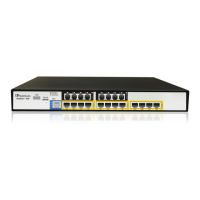2. Click the New button; the following page appears.
Figure 3-9: Selecting Device for Traffic Shaping
3. From the 'Device' drop-down list, select Default WAN device, and then click OK; the
following page appears:
Figure 3-10: Defining Traffic Shaping
4. In the ‘Tx Bandwidth’ field, specify the total WAN bandwidth (in Kbps) allocated by
your ITSP, for example, 5 Mbps (5000 Kbps) as shown in the figure above.
5. Click OK.
3.5.2 Defining VoIP Tx Traffic Shaping Classes
Once you have defined the total bandwidth allocated to the device's WAN interface, you
need to define a traffic shaping class to reserve a minimum bandwidth (e.g., of 1 Mbps) for
Tx VoIP traffic (SIP signaling and RTP packets) out of the total bandwidth (e.g., 5 Mbps).
To define traffic shaping class for VoIP traffic:
1. Open the Traffic Shaping page (see 'Defining Total WAN Bandwidth' on page 34) and
then click the Edit button corresponding to the 'Default WAN Device' entry.
2. In the 'Tx Traffic Shaping' group, click the New button.
Figure 3-11: Adding Class Rule
3. Assign a name to the new class (e.g., "VOIP Tx" as shown above), and then click OK;
the page closes and you are returned to the previous page.
4. Click the newly added class name; the following page appears:

